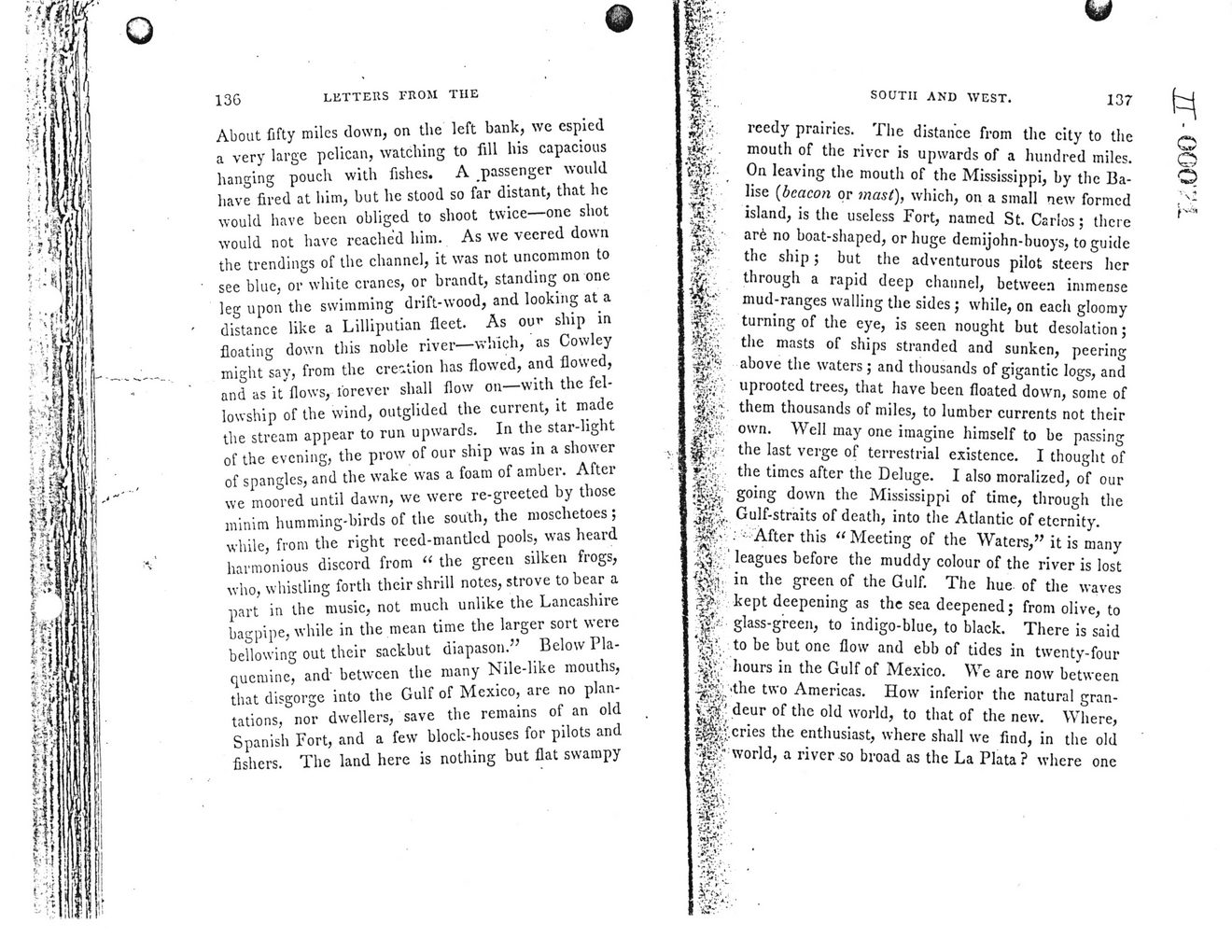This text was obtained via automated optical character recognition.
It has not been edited and may therefore contain several errors.
136 letters from tiie About fifty miles down, on the left bank, we espied a very large pelican, watching to fill his capacious hanging pouch with fishes. A passenger would have fired at him, but he stood so far distant, that he would have been obliged to shoot twice—one shot would not have reached him. As we veered down the trendings of the channel, it was not uncommon to see blue, or white cranes, or brandt, standing on one leg upon the swimming drift-wood, and looking at a distance like a Lilliputian fleet. As our ship in floating down this noble river—which, as Cowley might say, from the creation has flowed, and flowed, and as it flows, lorever shall flow on—with the fellowship of the wind, outglided the current, it made the stream appear to run upwards. In the star-light of the evening, the prow of our ship was in a shower of spangles, and the wake was a foam of amber. After we moored until dawn, we were re-greeted by those minim humming-birds of the south, the nioschetoes ; while, from the right reed-mantled pools, was heard harmonious discord from “ the green silken frogs, who, whistling forth their shrill notes, strove to bear a part in the music, not much unlike the Lancashire bagpipe, while in the mean time the larger sort were bellowing out their sackbut diapason.” Below Pla-quemine, and' between the many Nile-like mouths, that disgorge into the Gulf of Mexico, are no plantations, nor dwellers, save the remains of an old Spanish Fort, and a few block-houses for pilots and fishers. The land here is nothing but flat swampy SOUTII AND WEST. 137 reedy prairies. The distance from the city to the mouth of the river is upwards of a hundred miles. On leaving the mouth of the Mississippi, by the Ba-lise (beacon or mast), which, on a small new formed island, is the useless Fort, named St. Carlos; there ar& no boat-shaped, or huge demijohn-buoys, to guide the ship; but the adventurous pilot steers her through a rapid deep channel, between immense mud-ranges walling the sides; while, on each gloomy turning of the eye, is seen nought but desolation; the masts of ships stranded and sunken, peering above the waters ; and thousands of gigantic logs, and uprooted trees, that have been floated dowrn, some of them thousands of miles, to lumber currents not their own. Well may one imagine himself to be passing the last verge of terrestrial existence. I thought of the times after the Deluge. I also moralized, of our going down the Mississippi of time, through the Gulf-straits of death, into the Atlantic of eternity. • - After this “ Meeting of the Waters,” it is many leagues before the muddy colour of the river is lost in the green of the Gulf. The hue of the waves kept deepening as the sea deepened; from olive, to glass-green, to indigo-blue, to black. There is said to be but one flow and ebb of tides in twenty-four hours in the Gulf of Mexico. We are now between ■the two Americas. How inferior the natural gran-' deur of the old world, to that of the new. Where, [.cries the enthusiast, where shall we find, in the old world, a river so broad as the La Plata? where one f \ .090 - jr

Hancock County Letter-from-Gulf-of-Mexico-(3)